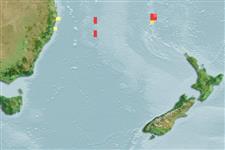>
Gobiiformes (Gobies) >
Gobiidae (Gobies) > Gobiinae
Etymology: Eviota: No etymology given, suggested by Christopher Scharpt: from Latin 'eu' for 'true' and 'iota' for anything very small, in combination 'truly very small' referring to it as being the smallest vertebrate at the time it has benn described by Jenkins (thus, making the suggestion by Scharpt plausible; readerae: Named for Sally E. Reader.
Eponymy: Sally E Reader is an ichthyologist at the Australian Museum Research Institute. [...] (Ref. 128868), visit book page.
More on authors: Gill & Jewett.
Environment: milieu / climate zone / depth range / distribution range
ນິເວດວິທະຍາ
ສັດທະເລ ກ່ຽວກັນຫີນ; ລະດັບຄວາມເລິກ 0 - 30 m (Ref. 59013). Temperate
Southwest Pacific, Middleton and Elizabeth Reefs on the Lord Howe Rise, Tasman Sea.
ຂະໜາດ / ນ້ຳໜັກ / Age
Maturity: Lm ? range ? - ? cm
Max length : 1.8 cm SL ຕົວຜູ້/ບໍ່ມີເພດ; (Ref. 59013)
Short description
ຕົວທີ່ໃຊ້ໃນການຈຳແນກຊະນິດ | ສະລີລະວິທະຍາ | ການວັດແທກຮູບຮ່າງລັກສະນະພາຍນອກຂອງດິນ,ສັດ,ປາ…
ຄີ (ໜາມ)ແຂງຢູ່ຫຼັງປາ (ທັງໝົດ) : 7; ຄີຫຼັງຂອງປາ (ຄີອ່ອນ) (ທັງໝົດ) : 9; ຄີ(ໜາມ) ແຂງຢູ່ຄີກົ້ນປາ
ກຸ່ມປາກະດູກແຂງ
ຄວາມຖີ່ຂອງກຸ່ມຖ່າຍທອດພັນ
ປາທີ່ມີການເຄື່ອນຍ້າຍຈາກທະເລໄປຫານ້ຳຈືດ ແລະນ້ຳຈືດຫາທະເລ
ປາທີ່ມີການເຄື່ອນຍ້າຍຈາກທະເລແລະໄປໄຂ່ຢູ່ນ້ຳຈືດ
ຄີກົ້ນຂອງປາ
ສັດທີ່ມີກະດູກສັນຫັຼງ
ການຖ່າຍທອດທາງກຳມະພັນຈາກພໍ່ແມ່ຫາລູກ: 1; ຄີກົ້ນຂອງປາ: 8; ສັດທີ່ມີກະດູກສັນຫຼັງ: 26. This species is distinct with the following set of characters: D VI + I, 9; A I, 8; with some pectoral-fin rays branched; fifth segmented pelvic-fin ray is lacking; cephalic sensory-pore system pattern 1; non-fimbriate male genital papilla; dark bars or saddles 12-13 on trunk from origin of spinous dorsal fin to mid peduncular spot, not extending below midline (except in small juveniles); pectoral-fin base with a prominent circular dark spot dorsally (sometimes with additional small diffuse spot ventrally) (Ref. 59013). Dorsal to anal fin-ray formula 9/8 (Ref. 116739).
Specimens were collected from tidal pools, lagoon patch reefs and reef slopes at depths from about 0.3 to at least 30 m (Ref. 59013). Benthic, also found in coral and rock reefs (Ref. 75154).
Life cycle and mating behavior
ການຈະເລີນເຕັມໄວ | ການສືບພັນ | ການວາງໄຂ່ | ໄຂ່ | ຄວາມດົກຂອງໄຂ່ປາ | ຕົວອ່ອນ
Gill, A.C. and S.L. Jewett, 2004. Eviota hoesei and E. readerae, new species of fish from the Southwest Pacific, with comments on the identity of E. corneliae Fricke (Perciformes: Gobiidae). Rec. Western Aust. Mus. 56:235-240. (Ref. 59013)
IUCN Red List Status (Ref. 130435: Version 2024-1)
Threat to humans
Harmless
Human uses
ເຄື່ອງມື
Special reports
Download XML
ແຫຼ່ງອີນເຕີເນັດ
Estimates based on models
Preferred temperature (Ref.
123201): 21 - 22.9, mean 21.6 °C (based on 15 cells).
Phylogenetic diversity index (Ref.
82804): PD
50 = 0.5000 [Uniqueness, from 0.5 = low to 2.0 = high].
Bayesian length-weight: a=0.01023 (0.00477 - 0.02194), b=3.01 (2.83 - 3.19), in cm total length, based on LWR estimates for this (Sub)family-body shape (Ref.
93245).
ຊັ້ນເຂດຮ້ອນ (Ref.
69278): 3.0 ±0.3 se; based on size and trophs of closest relatives
ຄວາມຢືດຢຸ່ນ (Ref.
120179): ສູງ, ປະຊາກອນຕຳ່ສຸດທີ່ໃຊ້ເວລາສອງໜ້ອຍກວ່າ 15 ເດືອນ (Preliminary K or Fecundity.).
Fishing Vulnerability (Ref.
59153): Low vulnerability (10 of 100).
Nutrients (Ref.
124155): Calcium = 158 [58, 726] mg/100g; Iron = 0.781 [0.259, 2.074] mg/100g; Protein = 18.2 [15.8, 20.3] %; Omega3 = 0.433 [0.105, 1.832] g/100g; Selenium = 8.29 [1.82, 33.67] μg/100g; VitaminA = 65.8 [7.9, 530.2] μg/100g; Zinc = 2.88 [1.29, 5.71] mg/100g (wet weight);
